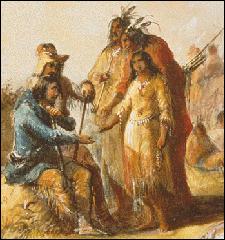
Secondary Source:

Books
“Clark,
William.” The World Book
Encyclopedia. Vol. 4.
Chicago: World Book Inc., 1998.
“Colonial Period to 1853.” Album of American History. Vol. I and II. New York: Charles Scribner’s Sons, 1981.
This encyclopedia entry contained pictures of the expedition and the general layout of surprising events of the voyage. This resource informed us of events in the trek that altered the Corps of Discovery’s course.“Lewis
and Clark Expedition.” The World Book Encyclopedia. Vol.
12. Chicago: World Book Inc., 1998.
“Lewis,
Meriwether.” The World Book Encyclopedia. Vol. 12.
Chicago: World Book Inc., 1998.
Internet
Adventure
into the Unknown: A WebQuest on the Lewis and Clark Expedition.
3 February 2001. <www.richmond.edu/~ed344/webquests/lewisclark/>
This website provided us with a picture of expedition, which allowed us to visualize one of the events that happened in the journey.
AITLC
Guide to Lewis and Clark. 3
February 2001. <tlc.ai.org/lewiclar.htm>
This website provided us with a map of the expedition route with all the territories of 1804 marked clearly. It explained to us the route taken and why a certain direction was used instead of the other.
The
Corps of Discovery. 24 January 2001. <www.halcyon.com/rdpayne/fcnm-corps.html>
Google.
29 January 2001. <www.google.com>
Lewis
and Clark Expedition. 2 February
2001. <www.lewis-clark.org>
Lewis
and Clark Expedition Web Cam Site. 3
February 2001. <www.lewisandclarkcam.com/>
Meriwether
Lewis (1774-1809) and William Clark (1770-1838). 29 January 2001. <tqjunior.thinkquest.org/4034/lewisandclark.html>
This website provided us with wonderful portraits of Meriwether Lewis and William Clark during the expedition.
Meriwether
Lewis-Lewis County-Hohenwald Tennessee. 29
January 2001. <www.piney.com/DornMLewis.html>
This website provided us with a background of the expedition.
Sacagawea.
29 January 2001. <www.geocities.com/CollegePark/Hall9626/NativeAmericans.html>
This source provided us with pictures of Native Americans and sites in the Louisiana Territory and the Pacific Northwest of the United States of America. The pictures helped us by giving us an insight of Indian life in the Northwest and why Lewis and Clark took certain approaches to maintain peace with the Native Americans.
Sacagawea.
22 January 2001. <www.pbs.org/lewisandclark/inside/saca.html.>
This website provided us with a picture of Sacagawea and also information of her childhood. The data helped us by giving us an insight of her life and the purposes of her actions and determination as she trekked along with the Corps of Discovery.
Sacagawea
(c. 1790-1812 or 1884). 29 January
2001. <www.pbs.org/weta/thewest/wpages/wpgs400.w4sacaga.htm>
This resource provided us with pictures of Sacagawea with her child and pictures of the Native Americans the Corps of Discovery encountered. It explained to us how Indian culture was and some of the decisions made by Lewis and Clark during serious and dangerous situations with the hostile Indians.
USA
Weekend: Take the Lewis and Clark Trail. 2
November 1997. 3 February 2001.
<www.usaweekend.com/97_issues/971102/lewis_and_clark/971102trail_intro.html>